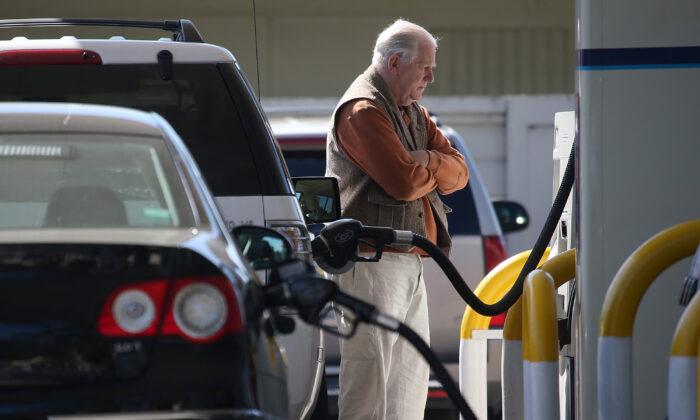Gasoline prices have risen to their highest seasonal level since 2012, defying expectations for significant relief at the pumps after the U.S. Labor Day weekend as oil prices have soared on Saudi production cuts.
The national average cost for a gallon of regular-grade gasoline was $3.811 as of Sept. 5, according to AAA data.
While that’s a slight decline from $3.813 per gallon recorded a day earlier and $3.831 a month prior, it’s higher than a year ago ($3.786) and unusually high for this time of year in historical terms.
The price on Sept. 5 is the second-highest for the first Tuesday in September (the day after Labor Day) since 1994, according to archival AAA price data cited by Bloomberg.
“The Labor Day weekend marks the unofficial end to the summer driving season, when gasoline demand is usually at its highest in the United States,” the Energy Information Administration (EIA) stated in an Aug. 30 report.
Typically, the end of the summer driving season is marked by expectations that pump prices will ease, although these expectations may fall flat as the EIA expects that crude demand will stay high amid relatively strong economic indicators in the United States combined with Saudi production cuts, along with other factors.
“We expect the production cuts, combined with increasing demand, will cause global oil inventories to fall and put upward pressure on crude oil prices through the end of this year,” the agency stated in its This Week in Petroleum report on Aug. 30.

‘Bit of a Bumpy Ride’
Ahead of the Labor Day weekend, the national average for a gallon of gasoline fell to its lowest level since July, even as oil prices have risen to their highest since November 2022.“Hurricane Idalia steered well clear of significant energy infrastructure, leading to zero impact on gas prices. With the switch back to winter gasoline less than two weeks away, we could eventually see more downward pressure on gas prices,” Patrick De Haan, head of petroleum analysis at GasBuddy, told The Epoch Times in an emailed statement.
“However, any disturbances that threaten the [Persian] Gulf could delay any decline between now and then, creating a bit of a bumpy ride for the next week or two before more relief arrives toward late September.”
The EIA’s Weekly Petroleum Status Report released on Aug. 30 showed a significant 10.6-million-barrel decline in U.S. commercial crude oil inventories, which Mr. De Haan said now stand at 3 percent below average for this time of year and 1.1 percent less than a year ago.

Saudi Production Cuts, Inventory Drawdowns
Crude inventories are likely to see further downward pressure as Saudi Arabia has extended its voluntary production cut of 1 million barrels per day for another three months, until the end of December, according to state-owned media.News of the Saudi production cut extension drove the October West Texas Intermediate (WTI) crude futures up by as much as 2 percent, with prices pushing above $87 a barrel on the New York Mercantile Exchange.
Brent crude, the international benchmark for oil prices, topped $90 a barrel on London’s ICE Futures exchange following news of the Saudi cutbacks.
WTI and Brent are up by 8 percent and 5 percent, respectively, year to date.
Last week’s oil rally combined with stable demand has helped put a floor under gasoline prices despite that there was less travel than usual over the Labor Day weekend.
“U.S. retail gasoline demand saw a 0.0 percent increase last week, as Labor Day travel appeared subdued and disappointing,” Mr. De Haan said.
While it’s unclear where supply and demand will go from here, some experts see a potential for price volatility going forward—including more increases in gasoline prices.
Inventories face pressure as the U.S. rig count continues to fall, coupled with more oil drawdowns, while demand has been surprisingly high.
“During the COVID shutdown, there were some that predicted that we would never see demand recover,” Phil Flynn, a senior market analyst at The PRICE Futures Group, said in his daily Energy Report on Sept. 5.
“Yet here we are with global demand at an all-time high of 103 million barrels a day in June driven by what the International Energy Agency said was better-than-expected economic growth in OECD [Organization for Economic Co-operation and Development] countries, strong summer air travel, and surging oil consumption in China, particularly for petrochemical production.”
“Don’t you hate it when the data does not fit the narrative,” he said, pointing to the fact that China’s Sinopec announced plans to adjust its demand forecasts and said that “peak domestic gasoline demand has already passed and it’s all downhill from here.”
So far this year, the U.S. oil rig count—a widely watched measurement of the number of active drilling rigs—has declined by nearly 18 percent, from 621 to 512, the lowest level since February 2022.
Meanwhile, U.S. gasoline inventories have been below the previous five-year average since March 2022, according to the EIA.
“Flat gasoline production has kept U.S. gasoline inventories low and, in combination with growing demand, has contributed to higher gasoline prices,” the EIA stated in its This Week in Petroleum report on Aug. 30.







